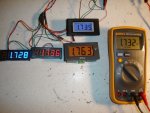- Joined
- Sep 20, 2008
- Messages
- 17,622
- Points
- 113
While working on the latest testing and developments of our
soon to be released DL-Module™ we discovered that not all
Digital Panel Meters are calibrated or created equal....
These are the Digital Panel Meters that are used in the older
Kenometers... nospin LPM... the Alpha and even our own Limited
Edition 5Watt LaserBee with Data Logging...
We hooked a few (brand new out of the box) in parallel... Then
used 2 Regulated variable power supplies and set one to 5volts
to power the Displays... and set the other regulated power supply
to an arbitrary output value..
We also hooked our Fluke DMM in parallel to the DPM inputs for reference...
There seems to be quite a variation from true voltage on some
of the DPMs (and only a small sampling) that makes me wonder
if that would falsify the LPM readings...
Granted some of the variations are minor... but we are trying to make
the DL-Module™ as accurate as possible to the voltage being applied
at the Digital Panel Meter terminals...
Jerry
soon to be released DL-Module™ we discovered that not all
Digital Panel Meters are calibrated or created equal....
These are the Digital Panel Meters that are used in the older
Kenometers... nospin LPM... the Alpha and even our own Limited
Edition 5Watt LaserBee with Data Logging...
We hooked a few (brand new out of the box) in parallel... Then
used 2 Regulated variable power supplies and set one to 5volts
to power the Displays... and set the other regulated power supply
to an arbitrary output value..
We also hooked our Fluke DMM in parallel to the DPM inputs for reference...
There seems to be quite a variation from true voltage on some
of the DPMs (and only a small sampling) that makes me wonder
if that would falsify the LPM readings...
Granted some of the variations are minor... but we are trying to make
the DL-Module™ as accurate as possible to the voltage being applied
at the Digital Panel Meter terminals...
Jerry
Attachments
Last edited:






